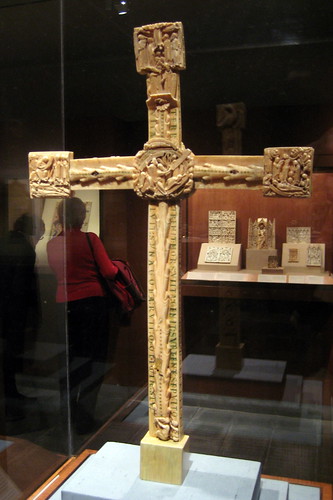
In Patrick Leigh Fermor’s incomparable A Time of Gifts, he takes the occasion of his 1933 visit to Dürnstein castle in Austria as an opportunity to recount the story of Richard the Lionheart‘s imprisonment there in 1193.
After lifting the siege of Acre in the Third Crusade, the story goes, Richard was offended by Leopold of Austria flying his standard too near to Richard’s. They quarrelled and Leopold left for home. Richard followed a year later, after reaching a truce with Saladin.
Travelling in disguise through Austria after being shipwrecked on a pirate ship at the head of the Adriatic, Richard was discovered by Leopold’s men either because of his good looks, his demand for roast chicken (supposedly a royal dish), or by the ‘careless splendor’ of his expensive gloves; accounts vary.
In any event, Richard was imprisoned in the castle at Dürnstein:
From the west barbican a long crenelated wall ran steeply up the mountainside to the tip of a crag that overhung both the town and the river… Lancets pierced the remains of the battlement walls, there were pointed arches and a donjon; but, except for the clustering stumps of the vaulting, all trace of a roof had gone and firs and hazel-saplings grew thick in the crumbing cincture. This wreckage was the fortress where Richard Coeur de Lion had been imprisoned. (A Time of Gifts, pp. 184-185)
Leopold turned Richard over to his suzerein, Henry VI, the Holy Roman Emperor, who demanded an enormous ransom of 150,000 marks (the equivalant of 65,000 pounds of silver, several times Richard’s entire annual revenue) for his return. His mother, Eleanor of Aquitaine, raised the ransom at the same time that Richard’s brother, John, offered the emperor 80,000 marks to keep him captive.
Legend says that Blondel, Richard’s minstrel, rescued him by “singing outside of every likely prison until his friend’s voice answered with the second verse.” Another legend says that Richard’s place was taken by a substitute hostage, Hugo de Morville, the murderer of Thomas a Becket on Richard’s father’s orders. Subseqeuently, that legend holds, he introduced Pervical, Tristan, Lancelot, and Yseult into German mythology.
In the 1980s, a Hungarian immigrant to the US claimed that he had seen what is now called the Cloisers Cross in the Cistercian monastery at Zirc in the 1930s. This incomparable little Romanesque masterpiece, intriciately carved from walrus ivory, is one of the glories of medieval art.
The immigrant’s account formed the basis of Norman Scarfe’s conjecture that the cross was a part of Richard’s ransom, since we know that Samson, the Abbot of Bury St. Edmond’s from 1180-1212, “was instrumental in raising the ransom, went to Dürnstein with many gifts, and contributed significant treasures from his own abbey church.” (Parker & Little, p.16 )
(Zirc is about 300 km. east of Dürnstein.)
Thomas Hoving, the Metropolitan Museum curator who bought the cross — a story memorably recounted in his King of Confessors — always ascribed it to Bury St. Edmond’s but was never able to explain how the Yugoslav art dealer Topic Mimara acquired it or where it had been for the intervening nine hundred years.
Did Samson take it to Dürnstein to ransom Richard?
————————–
Hoving, Thomas. King of the Confessors (New York: Simon and Schuster, 1981)
McPhee, John. A Roomful of Hovings (New York: Farrar, Straus and Giroux, 1969)
Parker, Elizabeth C. & Charles T. Little. The Cloisters Cross (New York: The Metropolitan Museum of Art, 1994)
Scarfe, Norman. Suffolk in the Middle Ages (Woodbridge, 1986)

